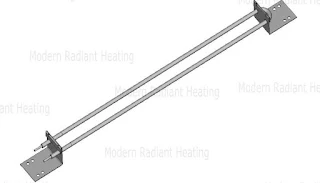A List of tubular heating elements applications might surprise you.
Tubular heating elements are used in a wide variety of applications across different industries. Here is an extensive list for you to check some of the areas where tubular heating elements are commonly used:
- Industrial Process Heating: Tubular heating elements are used in various industrial processes such as heating, drying, curing, sterilization, and calcination.
- Plastic and Rubber Industry: Tubular heating elements are used in extruders, injection molding machines, and other plastic and rubber processing equipment to provide heat.
- Food Processing Industry: Tubular heating elements are used in food processing equipment such as ovens, fryers, and sterilizers to maintain temperature and ensure food safety.
- Chemical Industry: Tubular heating elements are used in chemical processing equipment such as reactors, dryers, and distillation columns to provide heat.
- Pharmaceutical Industry: Tubular heating elements are used in pharmaceutical processing equipment such as ovens, dryers, and sterilizers to maintain temperature and ensure product quality.
- HVAC Industry: Tubular heating elements are used in heating coils, unit heaters, and other HVAC equipment to provide heat.
- Automotive Industry: Tubular heating elements are used in automotive applications such as engine cooling systems, exhaust gas recirculation (EGR) coolers, and turbochargers.
- Aerospace Industry: Tubular heating elements are used in aerospace applications such as aircraft engines, environmental control systems, and fuel systems.
- Oil and Gas Industry: Tubular heating elements are used in oil and gas processing equipment such as heat exchangers, furnaces, and boilers.
- Power Generation Industry: Tubular heating elements are used in power generation equipment such as boilers, turbines, and generators.
- Medical Industry: Tubular heating elements are used in medical equipment such as diagnostic imaging machines, surgical instruments, and patient warming devices.
- Packaging Industry: Tubular heating elements are used in packaging equipment such as form-fill-seal machines, cartoners, and case packers.
- Textile Industry: Tubular heating elements are used in textile processing equipment such as dryers, calenders, and heat transfer presses.
- Metal Processing Industry: Tubular heating elements are used in metal processing equipment such as annealing furnaces, quenching tanks, and tempering ovens.
- Semiconductor Industry: Tubular heating elements are used in semiconductor processing equipment such as diffusion furnaces, oxidation furnaces, and deposition systems.
- Water Heating: Tubular heating elements are used in electric water heaters, boilers, and industrial water heating systems to heat water quickly and efficiently.
- Laboratory Equipment: Tubular heating elements are used in laboratory equipment such as ovens, incubators, and dry baths to provide precise temperature control.
- Agriculture: Tubular heating elements are used in agriculture for applications such as crop drying, greenhouse heating, and soil warming.
- Marine: Tubular heating elements are used in marine applications for heating engine coolant, cabin heaters, and de-icing systems.
- Mining: Tubular heating elements are used in mining applications for heating process fluids, thawing frozen pipes, and maintaining temperatures in mining equipment.
- Metal Fabrication: Tubular heating elements are used in metal fabrication equipment such as bending machines, forming machines, and welding equipment to provide heat.
- Printing and Paper Industry: Tubular heating elements are used in printing and paper processing equipment such as dryers, calenders, and coating machines.
- Ceramics: Tubular heating elements are used in ceramic processing equipment such as kilns, dryers, and furnaces.
- Electronics: Tubular heating elements are used in electronics for applications such as soldering, brazing, and curing.
- Water Treatment: Tubular heating elements are used in water treatment equipment such as heaters, sterilizers, and filters.
- Telecommunications: Tubular heating elements are used in telecommunications equipment such as antennas, towers, and shelters.
- Paints and Coatings: Tubular heating elements are used in paint and coating applications for drying and curing.
- Woodworking: Tubular heating elements are used in woodworking equipment such as dryers, ovens, and laminators.
- Environmental: Tubular heating elements are used in environmental applications such as air pollution control systems, water treatment plants, and waste management facilities.
- Research and Development: Tubular heating elements are used in research and development applications for various testing and experimentation purposes.
- Brewing and Distillation: Tubular heating elements are used in brewing and distillation equipment such as stills, mash tuns, and fermenters to control temperature and ensure consistent product quality.
- Cosmetics and Personal Care: Tubular heating elements are used in cosmetics and personal care applications for heating and drying products such as lotions, creams, and makeup.
- Pharmaceutical Packaging: Tubular heating elements are used in pharmaceutical packaging equipment such as blister pack machines and cartoners to provide precise temperature control.
- Medical Imaging: Tubular heating elements are used in medical imaging equipment such as MRI machines, X-ray machines, and ultrasound machines to maintain temperature and ensure accurate imaging.
- Food Packaging: Tubular heating elements are used in food packaging equipment such as form-fill-seal machines, tray sealers, and vacuum packaging machines to provide precise temperature control.
- Plastics Recycling: Tubular heating elements are used in plastics recycling equipment such as shredders, granulators, and wash lines to heat and melt plastics.
- Solar Energy: Tubular heating elements are used in solar energy applications such as solar water heaters, solar panels, and solar thermal systems to provide heat.
- Textile Printing: Tubular heating elements are used in textile printing equipment such as screen printing machines, digital printing machines, and transfer printing machines to provide precise temperature control.
- Heat Exchangers: Tubular heating elements are used in heat exchangers such as shell and tube heat exchangers, plate heat exchangers, and spiral heat exchangers to transfer heat.
- Compressed Air: Tubular heating elements are used in compressed air systems such as dryers, filters, and chillers to provide precise temperature control.
- Industrial Cleaning: Tubular heating elements are used in industrial cleaning equipment such as pressure washers, steam cleaners, and parts washers to heat water and cleaning solutions.
- Food Processing: Tubular heating elements are used in food processing equipment such as cookers, fryers, and ovens to provide precise temperature control.
- Power Generation: Tubular heating elements are used in power generation equipment such as generators, transformers, and switchgears to maintain temperature and prevent overheating.
- Industrial Ovens: Tubular heating elements are used in industrial ovens such as curing ovens, drying ovens, and baking ovens to provide precise temperature control.
- Chemical Processing: Tubular heating elements are used in chemical processing equipment such as reactors, mixers, and separators to heat and maintain temperature.
Aircraft: Tubular heating elements are used in aircraft for various applications such as engine heating, cabin heating, and wing and tail surface de-icing. - Railway: Tubular heating elements are used in railway applications for various purposes such as train heating, switch heating, and snow and ice melting.
- Marine: Tubular heating elements are used in marine applications for various purposes such as engine cooling, cabin heating, and de-icing of ship decks and propellers.
- Automotive: Tubular heating elements are used in automotive applications for various purposes such as engine cooling, cabin heating, and windshield de-icing.
- Construction: Tubular heating elements are used in construction applications for various purposes such as concrete curing, floor heating, and pipe freezing prevention.
- Environmental: Tubular heating elements are used in environmental applications for various purposes such as air and water treatment, soil remediation, and waste disposal.
- Energy: Tubular heating elements are used in energy applications for various purposes such as power generation, oil and gas production, and geothermal heating.
- Mining: Tubular heating elements are used in mining applications for various purposes such as mineral processing, mineral drying, and mineral heating.
- Petrochemical: Tubular heating elements are used in petrochemical applications for various purposes such as distillation, cracking, and reforming.
- Pharmaceutical: Tubular heating elements are used in pharmaceutical applications for various purposes such as sterilization, decontamination, and drying.
- Medical: Tubular heating elements are used in medical applications for various purposes such as incubation, sterilization, and heating of medical gases.
- Food Service: Tubular heating elements are used in food service applications for various purposes such as cooking, baking, and frying.
- Textile: Tubular heating elements are used in textile applications for various purposes such as dyeing, finishing, and heat setting.
- Paper: Tubular heating elements are used in paper applications for various purposes such as drying, calendering, and coating.
- Printing: Tubular heating elements are used in printing applications for various purposes such as drying, curing, and fusing.Though this is just a common and a handful list of tubular heating elements usage, Tubular heater have many and vast application area thus making the most sought heater in the heater market.

